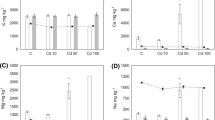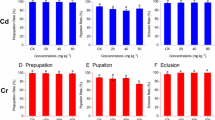Abstract
Newly hatched F1 nymphs of Aiolopus thalassinus (Fabr.) were fed on food treated with various concentrations of HgCl2, CdCl2, and PbCl2 until the end of adult life. Toxicological observations were followed in the F1 generation and in the F2 generation derived from the heavy metal-loaded F1 parents.
The highest concentration of the heavy metals caused 100% mortality of the F1 adults within four weeks. The nymphal duration of the F1 and F2 generations was significantly prolonged after Hg and Cd exposure, but the F1 of the group treated with lead was not affected. The fresh body weight of adults was significantly reduced in the F1 generation of most treatments and in the resulting untreated F2. The lifespan of the F1 adults was shortened. In the F2 generation, although the lifespan was somewhat longer, generally it was still shorter than that of the control adults. The mean egg number laid by F1 adults fed on food contaminated with Hg or Cd was decreased. This decrease was more pronounced in the case of Cd than Hg. In the females fed on food treated with Pb the reduction of the number of egg pods was not remarkable. The hatchability of the eggs laid by F1 females was significantly reduced as compared to the control. The viability of the eggs laid by F2 adults was somewhat decreased due to either a reduced number of egg pods or to a lower rate of hatchability, especially in the case of Cd. The treated adults frequently displayed weakness in their legs, difficulties in walking, tremors, and nervous movements. In 1% of the F1 adults, the wings were abnormally developed being outstretched and bent downward. The last instar nymphs hatching from eggs laid from F1 adults in PbCl2-treated soil failed to moult to adults.
Similar content being viewed by others
References
Abbasi SA, Nipaney PC, Soni R (1985) Environmental consequences of the inhibition in the hatching of pupae of Aedes aegypti by mercury, zinc and chromium—the abnormal toxicity of zinc. Int J Environ Stud 24(2):107–114
Aoki Y, Hatakeyama S, Kobayashi N, Sumi Y, Suzuki T, Suzuki KT (1989) Comparison of cadmium-binding protein induction among mayfly larvae of heavy metal resistant (Baetis thermicus) and susceptible species (B. yoshinensis and B. sahoensis). Comp Biochem Physiol 93C:345–347
Armstrong FAJ, Uthe JF (1971) Semiautomated determination of mercury in animal tissue. At Absorp Newl 10:101–103
Baccetti B, Capra F (1988) Notulae Orthopterologicae. 46. Revisione delle specie mediterranee del gen. Acrotylus Fieb. Redia (Firenze) 71(2):565–588
Brugger G (1981) Schwermetalle in Nahrungskette und Umwelt. In: Wieser W (ed) Expeditionen in die Wirklichkeit. Bonn Aktuell, pp 135–197
Cheng L (1980) Incorporation of cadmium into Drosophila. Environ Pollut (Series A) 21:85–88
Donald RC Jr (1979) Lead concentrations: Bats vs. terrestrial small mammals collected near a major highway. Environ Science Technol 13:338–340
Edens FW, Benton E, Bursian SJ, Morgan GW (1976) Effect of dietary lead on reproductive performance in Japanese quail, Coturnix japonica. Toxicol Appl Pharmacol 38:307–314
Eisler R (1971) Cadmium poisoning in Fundulus heteroditus (Pisces: Cyprinodontidae) and other marine organisms. J Fish Res Board 28:1225–1234
Farkas R (1989) Changes in gene expression of Drosophila embryos induced by heavy metals. In: Tonner M, Soldan T, Bennettova B (eds) Regulation of insect reproduction IV. Czech Acad Sci, Prague, pp 335–342
Hatch WR, Ott WL (1968) Determination of sub-microgram quantities of mercury by atomic absorption spectrophotometry. Anal Chem 40:2085–2087
Hunter BA, Johnson MS, Thompson DJ (1987) Ecotoxicology of copper and cadmium in a contaminated grassland ecosystem. II. Invertebrates. J. Appl Ecol 24:587–599
Keller Th, Baio S, Wittenbach A (1986) Gehalte einiger Elemente in den Ablagerungen auf Fichtennadeln als Nachweis der Luftverschmutzung. Allg Forst/Jagd Ztg 157:69–77
Kloke A (1977) Orientierungsdaten für tolerierbare Gesamtgehalte einiger Elemente in Kulturböden. Mitt Verband Dt landwirtsch Unters Forschungsanst H2:32–38
Kojo M-R, Lodenius M (1989) Cadmium and mercury in macrofungimechanisms of transport and accumulation. Angew Bot 63:279–292
Koski E, Venäläinen M, Nuorteva P (1988) The influence of forest type, topographic location and season on the levels of Al, Fe, Zn, Cd and Hg in some plants in Southern Finland. Ann Bot Fennici 25:365–370
Lindquist L (1988) Transport of cadmium from herbs to insects in a terrestrial environment. Entomol Tidskr 109(3–4):119–122
Lodenius M (1989) Biological monitoring of airborne mercury. In: Brasser LJ, Mulder WC (eds) Man and his Ecosystem. Proc 8th World Clean Air Congress, Sept 11–15, 1989, The Hague, The Netherlands. Vol 3, pp 159–164
--(1990) Environmental mobilization of mercury and cadmium. Department of Environmental Conservation, Univ. of Helsinki, Nr 13: 32 pp
Maehara N, Uchino E, Terayama K, Ohno H, Yamamura K (1986) Motor nerve conduction velocity (MCV) and lead content in sciatic nerve of lead-exposed rats. Bull Environ Contam Toxicol 37:47–52
Martoja R, Bouquegneau JM, Verthe C (1983) Toxicological effects and storage of cadmium and mercury in an insect Locusta migratoria (Orthoptera). J Invertebr Pathol 42:17–32
Mathew C, Al-Doori Z (1976) The mutagenic effect of the mercury fungicide Ceresan M in Drosophila melanogaster. Mutation Res 40:31–36
Meyer W, Sagredos AN (1986) Biochemical and histochemical aspects of lead exposure in dragonfly larvae (Odonata: Anisoptera). Ecotoxicol Environ Saf 11(3):308–319
Nuorteva P, Häsänen E, Nuorteva SL (1978) Bioaccumulation of mercury in sarcosaprophagous insects. Norw Ent 25:79–80
Nuorteva P, Nuorteva SL (1982) The fate of mercury in sarcosaprophagous flies and in insects eating them. Ambio 11:34–37
Quimby PC Jr, Frick KE, Wauchope RD, Kay SH (1979) Effect of cadmium on two biocontrol insects and their host weeds. Bull Environ Contam Toxicol 22:371–378
Ramel C, Magnusson J (1969) Genetic effects of organic mercury compounds. Hereditas 61:231–254
Rauter W (1976) Aufnahme von Quecksilber aus der Umgebungsluft durch Pflanzen und seine Speicherung im pflanzlichen Gewebe. Z Lebensm Unters Forsch 162:1–6
Roberts RD, Johnson MS, Firth JNM (1979) Predator prey relationships in the food chain transfer of heavy metals. In: Hemphill DD (ed) Trace substances in environmental health—XIII. University of Missouri, Columbia
Rossaro B, Gaggino GF, Marchetti R (1986) Accumulation of mercury in larvae and adults Chironomus riparius (Meigen). Bull Environ Contam Toxicol 37(3):402–406
Saha AK, Chatterjee SC, Goswani SK (1986) Mutagenic response of spermatocytic chromosomes of an acridid grasshopper to mercuric chloride. Environ Ecol 4:320–323
Scheffer F, Schachtschabel P (1982) Lehrbuch der Bodenkunde—11. Aufl, Enke-Verlag, Stuttgart, 442 pp
Schmidt GH (1981) Growth and behaviour of Acrotylus patruelis (H.-S.) larvae in temperature gradients under laboratory conditions. Zool Anz Jena 206:11–25
— (1986) Use of grasshoppers as test animals for the ecotoxicological evaluation of chemicals in the soil. Agriculture, Ecosystems Environ 16:175–188
Schmidt GH, Fielbrand B (1987) Wirkung einer simulierten Dauerbelastung durch HgCl2 auf die Generationsfolge der Feldheuschrecke Acrotylus patruelis (H.-S.) (Orth., Acrididae). Anz Schädlingskde Pflanzen- Umweltschutz 60:84–90
—, — (1988) Quecksilber-Dauerbelastung und Feld-heuschreckenentwicklung. Mitt Dtsch Ges Allg Angew Ent 6:464–487
Schmidt GH, Ibrahim NMM, Abdallah MD (1991) Toxicological studies on long-term effects of heavy metals (Hg, Cd, Pb) in the soil on the development of Aiolopus thalassinus (Fabr.) (Saltatoria: Acrididae). Sci Total Environ 107:109–133
Seidman LA, Bergstrom G, Gingrich DJ (1986) Accumulation of cadmium by the fourth instar larva of the fly Chironomus thummi. Tissue Cell Edinburgh 18(3):395–405
Sharma GP, Sobti RC, Chaudhry A, Ahluwalia KK (1988) Genotoxicity of two heavy metal compounds—lead acetate and mercuric chloride in the mosquito Anopheles stephensi (Liston) (Culicidae: Diptera). Cytologia 53(2):263–267
Sivapalan P, Guanapragasam NC (1980) Influence of copper on the development and adult emergence of Homona coffearia (Lepidoptera: Tortricidae) reared in vitro. Entomol Exp Appl 28:59–63
Snodgrass RE (1935) Principles of insect morphology. McGraw-Hill, NY, 667 pp
Soechtig W (1989) Schwermetallakkumulation verschiedener Grössenklassen der Larven von Baetis rhodani Pict. (Beatidae: Ephemeroptera) in der Oker bei Goslar/Probsteiburg (Niedersachsen). Braunschw Naturkd Schr 3(2):561–565
Staiger K (1983) Zur Bewertung der Quecksilberaufnahme über den Pflanzenspross. Arch Acker- Pflanzenbau Bodenkunde, Berlin, DDR 27:279–286
Sumi Y, Suzuki T, Yamamura M, Matakeyama S, Sugaya Y, Suzuki KT (1984) Histochemical staining of cadmium taken up by the midge larva Chironomus yoshimatsui (Diptera, Chironomidae). Comp Biochem Physiol, Oxford 79A(3):353–357
Vogel WR (1986) Zur Schwermetallbelastung der Borkenkäfer. Entomol Exp Appl 42:259–269
Weismann L, Skrobak J (1980) Toxicity of food with increased content of lead for caterpillar Scotia segetum (Den. & Schiff.) (Lepidoptera). Biologia (Bratislava) 35:823–826
Weismann L, Svatavakova L (1981) The influence of lead on some vital manifestations of insects. Biologia (Bratislava) 36(2):147–151
Williams KA, Green DWJ, Pascoe D, Gower DE (1986) The acute toxicity of cadmium to different larval stages of Chironomus riparius (Diptera: Chironomidae) and its ecological significance for pollution regulation. Oecologia 70(3):362–366
Wilson JR, Mittler TE (1987) Chronic mercury vapor poisoning of aphids. Experientia 43(3):334–335
Zelenayova E (1987) Scotia segetum (Lepidoptera, Noctuidae) oogenesis affected by copper ions added to semisynthetic diet of larvae. Biologia (Bratislava) 41(6):563–577
— (1988) Intoxication of pupae Galleria mellonella (Lepidoptera) by CdCl2 affected oogenesis of adults. In: Proc Int Conf Endocrinological Frontiers in Physiological Insect Ecology. Tech Univ of Wroclaw, Vol I, pp 461–465
Zelenayova E, Weissmann L (1983) The effect of CdCl2 in the semisynthetic food of caterpillars upon the gonads of imagos of Scotia segetum (Den. & Schiff.) (Lepidoptera: Noctuidae). Biologia (Bratislava) 38(10):941–948
—, — (1984) The effect of CdCl2 in the semisynthetic food of caterpillars upon the development of gonads of Scotia segetum (Den. & Schiff.) imagos (Lepidoptera: Noctuidae). Biologia (Bratislava) 39(2):121–127
Author information
Authors and Affiliations
Rights and permissions
About this article
Cite this article
Schmidt, G.H., Ibrahim, N.M.M. & Abdallah, M.D. Long-term effects of heavy metals in food on developmental stages of Aiolopus thalassinus (Saltatoria: Acrididae). Arch. Environ. Contam. Toxicol. 23, 375–382 (1992). https://doi.org/10.1007/BF00216248
Received:
Revised:
Issue Date:
DOI: https://doi.org/10.1007/BF00216248




